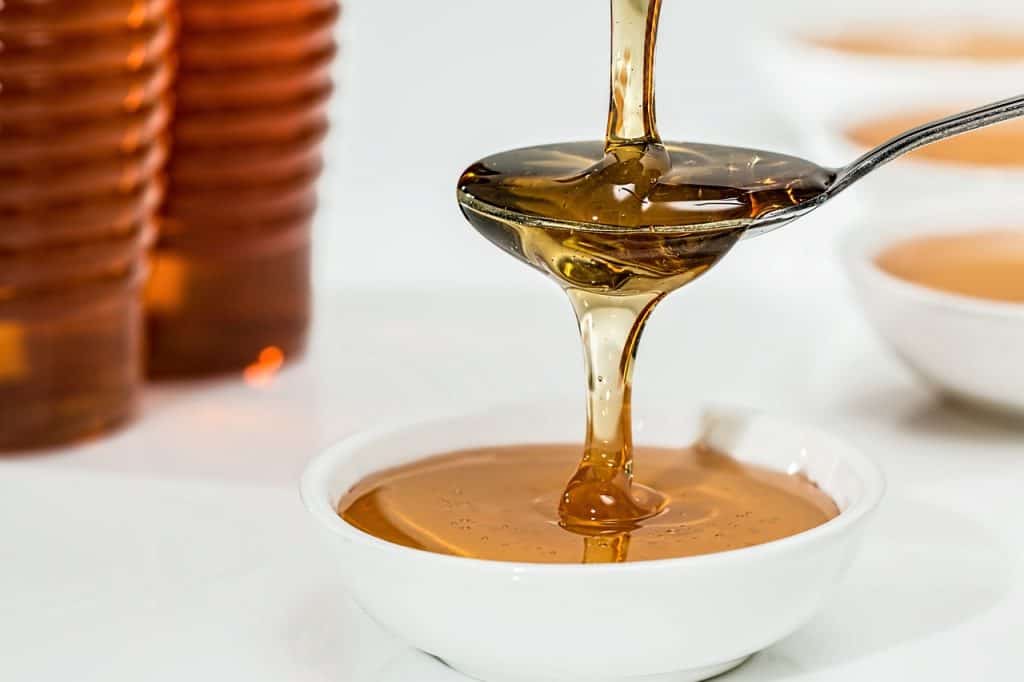If your dog has started itching and scratching non-stop, it’s more than likely they have caught mange. While mange can be unmanageable, you and your dog are in luck! There are plenty of home remedies for mange in dogs that can ease, soothe, and heal your itchy dog- while at the same time, even preventing mange from ever coming back!
I am an avid dog lover with three of my own and I always look to home remedies to help them out. Nothing is more important to me than the health of my dogs and I want to share the knowledge I have found with you so you too can safely, and naturally, bring your dog back to their normal state of health.
How Do Dogs Get Mange?
Mange is a highly contagious skin disease that affects dogs of all ages and breeds. It’s important to keep your pup protected from this pesky condition, but what do you know about it? Let us tell ya! There are two types:
Sarcoptic Mange is a very contagious skin condition that is caused by the Sarcoptes scabies mite. These mites, also referred to as scabies, will burrow into your dog’s skin. When they burrow into your dog’s skin, they will cause intense itching and irritation that will cause your dog to scratch. Oftentimes, scabies or sarcoptic mange will cause your dog to lose their fur due to the high amounts of itching.
While sarcoptic mange is treatable and can be cured with a careful eye and strict treatment regime, sarcoptic mange is contagious to humans and other pets.
Demodectic Mange is another intensely itchy skin condition caused by a mite called the Demodex mite. The Demodex mites will burrow into the dog’s skin and hair follicles and cause intense itching and irritation. While Demodex is contagious between dogs and cats, humans do not have to worry about transmitting the Demodex mite.
In order for you to correctly diagnose your dog for the type of mange they have, you will need to go to the vet for a skin scraping. Your vet will take a small sample of skin from your dog by scraping a small layer of skin from the affected area. Your vet will then examine the skin scraping sample under a microscope where they will be able to identify the type of mange your dog has.
While treatment of mange will be similar for both types, it will give you peace of mind to know what type of mange your dog has.
Symptoms of Dog Mange
Both sarcoptic and demodectic mange have similar traits when a dog catches it. The signs and symptoms of mange can include:
- Lesions occurring in patches
- Intense itching and non-stop scratching
- Loss of hair (also known as alopecia)
- Redness of the skin
- Appearance of scales
- Patches of mange appearing on the face, trunk, or legs
- Crust forming in the affected areas
- Sensitive skin in affected areas
- Bleeding (due to the high amounts of scratching)
- Open sores (caused by the high amounts of scratching)
- Painful to touch the affected areas (caused by the high amounts of scratching)
- Discolored discharge from affected areas
- Scabs forming in affected areas
- Red pustules form followed by discharge
- Eventually seeing weight loss and lethargy
- Enlargement of lymph nodes
- Discoloration in the skin
When your dog begins to develop symptoms of mange, it will typically exhibit multiple signs and symptoms at once. Mange will come on pretty quickly once the mites have begun to breed and multiply within your dog.
Once you have started to notice the signs and symptoms of mange appearing on your dog, take them to the vet immediately for a proper diagnosis- so you too do not catch mange! After a diagnosis, you can begin treating your dog for mange with home remedies.
Please keep in mind that if your dog does indeed have sarcoptic mange, you will need to quarantine your dog so you and your family or other pets do not catch it too.
13 Natural Mange Remedies in Dogs
Mange is quite common among dogs and cats and there are several herbal remedies that will be gentle on their skin and help eliminate any mange present.
1. Apply Aloe Vera
Aloe Vera contains high amounts of anti-parasitic compounds as well as being a natural antiseptic. Aloe Vera will also help to soothe your dog’s irritated skin with its natural cooling effect.
Required Ingredients:
- Aloe Vera (either in plant form or in bottled form)
Process:
- Directly apply the Aloe Vera onto the affected areas.
- Gently rub in the Aloe Vera into the dog’s skin and leave it to fully absorb.
- Repeat twice per day until the mange has fully healed.
Notes: Since Aloe Vera is natural, it will not harm your dog should they lick it off their skin. Try to avoid letting your dog lick the affected areas, however, so the Aloe Vera has a chance to work.
2. Lemon is Effective for Mange
Lemons might seem a strange cure for mange, but the acidic nature of this citrus fruit is perfect for killing mites and parasites. In addition to this, some studies have found that lemon oil is effective against mange in rabbits.
But are lemons safe for your dog? Yes, as long as you apply it externally and make sure that your dog doesn’t ingest any of the liquid. Otherwise, Fido is bound to experience some stomach discomfort.
Required Ingredients:
- Lemon
- Kettle
- Water
- Knife
- A sponge
Process:
- Slice one lemon. Do not peel it.
- Pour water into the kettle and put it on the stove.
- Wait for the water to start boiling and put the lemon slices in it.
- Leave the mixture overnight.
- On the next morning, get your dog to his usual bathing place.
- Pour the water/lemon mixture into a big basin.
- Soak the sponge into the mixture.
- Start washing your dog and applying the lemon water on the affected places.
Notes: While there is no denying that lemons can kill mites, they can also irritate your dog’s skin. So, this home remedy for mange in dogs is not suitable for animals with sensitive skin or other skin problems.
3. Administer Apple Cider Vinegar
Apple cider vinegar is a powerful home remedy that is useful for a wide variety of ailments including mange. Allowing your dog to ingest apple cider vinegar will help to fight the mange from the inside out.
Required Ingredients:
- Organic Apple Cider Vinegar
Process:
- Add a few tablespoons of Apple Cider Vinegar to your dog’s normal meal once per day.
- Repeat each day until the mange has cleared up.
Notes: While this remedy is effective, you will see more potency and faster healing time when you administer apple cider vinegar alongside other home remedies.
4. Apply Honey
Applying honey to your dog’s skin will help to soothe their irritated areas as well as fight the mange on your dog. The honey will instantly suffocate any mange and manage larvae present on your dog’s skin. In addition, honey will also promote healing in the skin. Just be sure your dog does not lick it off, otherwise, it won’t work!
Required Ingredients:
- Raw, organic honey
Process:
- Directly apply honey to the affected areas and gently rub it into the skin.
- Leave on your dog for at least 10 to 15 minutes before gently wiping away.
- Repeat twice per day until the mange is cleared up.
5. Apply Yogurt
Yogurt is full of healthy bacteria that can fight against any discharge and irritation that is caused by your dog’s mange. The acidophilus bacteria that is present in yogurt will help to soothe the irritation and discharge caused as a side effect from mange due to the itching.
Required Ingredients:
- Organic, unflavored yogurt
Process:
- Directly apply one tablespoon of yogurt to any areas that are irritated, inflamed, and/or have discharge, including the ears.
- Allow the yogurt to remain in place for 10 to 15 minutes before gently wiping away.
- Repeat twice per day to help assist the symptoms of side effects from mange until the mange is cleared up.
Notes: Yogurt will not cure mange, it will only help soothe the side effects caused by mange and should be used alongside other home remedies. Also, you should not let your dog lick the yogurt or it will not be able to work.
6. Apply Olive Oil
Olive oil is a gentle, yet powerful home remedy for fighting against mange. When it is applied to your dog’s skin, it will suffocate any adult mange, larvae, and eggs present in your dog’s skin. Olive oil is also helpful for relieving any inflammation or waxy build-up that is caused by the mange.
Required Ingredients:
- 1-3 tablespoons of Olive Oil
Process:
- Directly apply the olive oil to your dog’s affected areas.
- Allow the olive oil to rest on your dog’s skin for 10 to 15 minutes, before gently wiping away.
- Repeat twice per day until the mange is no longer present.
7. Bathe Your Dog
While it might seem obvious, one of the best things you can do for your dog is to give it a nice warm bath. Frequently bathing your dog while they have mange will help to soothe their irritated skin as well as remove any mange present on the skin. Using a mild soap will not further irritate your dog’s skin and the alkaline in the soap will help to eliminate the mange as well.
Required Ingredients:
- Gentle and mild soap
- Warm water
Process:
- Draw a bath for your dog and make sure the temperature is warm, but not too hot, so you do not burn your dog’s skin.
- Place your dog in the bath and wet their fur.
- Lather their fur with the soap and gently scrub their skin.
- Allow the soap to remain on your dog for five minutes before rinsing.
- Repeat at least every other day until the mange is no longer present.
8. Cleaning Your Dog’s Environment
Keeping your dog’s bedding and cages clean during this time will help to prevent re-infestation of mange as well as the spread of mange between humans and other animals. You should be sure to fully sterilize their bedding, toys, crates and/or cages, as well as their food bowls quite regularly during this time.
Required Ingredients:
- Gentle cleaning supplies
- Boiled water
Process:
- Scrub and clean any materials that are hard surfaced.
- Boil any food bowls and toys.
- Wash their bedding in hot water and dry on high heat.
- Repeat every other day until the mange has cleared up.
Notes: Keeping your dog’s environment clean and sterilized will help prevent the spread of bacteria, viruses, and parasites, including mange. It is recommended to regularly clean your dog’s environment once a week while they are healthy.
9. Applying Hydrogen Peroxide and Borax Mixture
This home remedy for mange in dogs is one of the most commonly used among homeopaths and even vets. This is due to the high levels of potency against mange and how effective it is when fighting mange and healing your dog’s skin. However, if your dog ingests this mixture, it can make them very ill.
I personally recommend using this remedy along with a muzzle to prevent your dog from licking it off and becoming sick.
Required Ingredients:
- 1 tablespoon of Hydrogen peroxide
- 1 tablespoon of Borax
- 1 cup of water
- Muzzle
Process:
- Combine the hydrogen peroxide, water, and borax and mix thoroughly.
- Place the muzzle on your dog.
- Apply the mixture directly to the affected areas and allow it to dry. It should take about 10 minutes.
- When the mixture has fully dried allow it to remain on your dog for about half an hour.
- Give your dog a bath afterward to remove any dead mange and soothe their skin. A bath will also help to ensure your dog does not ingest any of this mixture.
- Remove the muzzle.
- Repeat once per week while your dog has mange.
10. Applying Neem Oil
Neem oil is excellent for a variety of skin conditions as it is a highly effective anti-bacterial, anti-microbial and anti-viral agent. Neem oil can be combined with use alongside the hydrogen peroxide mixture for extra healing power.
Neem is a gentle yet powerful natural remedy for mange as it will treat any infection your dog has developed, soothe their irritated skin, cleanse the skin, nourishes the skin, and helps promote the regrowth of their fur.
Required Ingredients:
- One bottle of Neem essential oil
Process:
- Directly apply a liberal amount of neem oil to the affected areas.
- Repeat twice per day until there is no longer any mange present and your dog’s fur has regrown.
11. Applying an Herbal Tea Mixture
Herbal teas can soothe your dog’s irritated skin and promote fast healing in the skin. Arnica, calendula, and yellow dock herbs are ancient herbal remedies that are used for a variety of ailments in and outside the body of both humans and animals.
Arnica herb is great for promoting the healing of scabs, bruises, and swelling. Calendula can assist in the inflammation of the skin. Yellow dock contains the healing properties of both arnica and calendula. Combining the three herbs can provide a powerful kick that can boost the healing process of a mange infestation.
Required Ingredients:
- 1 teaspoon of Arnica herbal tea
- 1 teaspoon of Yellow dock herbal tea
- 1 teaspoon of Calendula herbal tea
- Hot water
- Strainer
- Sponge
Process:
- Bring the water to a boil and add all three of the herbal teas.
- Let them simmer for two minutes and turn off the heat. Allow the tea to steep for three to five minutes.
- Strain the tea from the water and allow it to cool.
- Soak the sponge in the tea mixture and gently apply the tea-soaked sponge onto your dog’s skin.
- Leave to dry- do not wipe off.
- Repeat twice per day while your dog is suffering from mange.
Notes: These herbal teas are safe for your dog to ingest, but it is best to disallow them from licking their affected areas so they do not further irritate their skin.
12. Applying Colloidal Silver
Colloidal Silver is used as a cure-all for several ailments, internal and external, in both humans and in dogs. This is because Colloidal Silver is a powerful anti-viral, anti-bacterial, anti-microbial, and anti-fungal agent while at the same time, promoting healing of the affected areas.
You can do a few things with the Colloidal Silver to help your dog during this time. I recommend adding a teaspoon to their food or drinking water once per day as well as adding it in with their bath- alongside the below home remedy.
Required Ingredients:
- One bottle of Colloidal Silver
Process:
- Apply several drops of Colloidal Silver directly to the affected areas and allow them to dry.
- This remedy can also be used in your dog’s ears should they be affected by mange as well.
- Repeat two to three times per day while your dog is suffering from mange.
Notes: Colloidal Silver will be a great supplement to use alongside any other home remedy.
13. ApplyingSulfur
Sulfur is often used in a wide variety of skin conditions in cats and dogs. It will work to suffocate the mange present on your dog while promoting healing of the skin. Sulfur will also help with any discharge or infection your dog may have that has been caused by the mange.
Just be aware, that while it is a powerful home remedy for mange in dogs, it does have an unpleasant smell.
Required Ingredients:
- 1 bottle of Sulphur
Process:
- Apply 1 tablespoon of Sulphur directly to the affected areas and leave it on your dog for at least one hour.
- You may choose to wash it off (due to the smell) or you can allow it to remain on your dog’s skin.
- Repeat once daily until your dog no longer has mange.
In addition to these natural remedies for mange in dogs, there are a few other tips that I can recommend that will aid in the healing process and help to prevent a re-infestation or further spread of the mange. Please be sure to adhere to the following while your dog has mange:
- Bathe your dog regularly.
- Limit your dog’s contact with other animals and humans and/or place your dog in quarantine should your dog have sarcoptic mange.
- Clean and sanitize your dog’s environment regularly.
- Avoid milk and packaged and canned products.
- Provide a vitamin-rich diet to keep your pet’s immune system high and to promote internal healing and fur regrowth.
- Brush and even comb your dog’s fur each day and check for mites.
- Do not allow your dog to come into contact with other dogs or cats.
- Keep your dog away from infected dogs or cats.
- Wash your dog’s bedding regularly.
- Do not take them out to dog parks or other areas where they could come into contact with other dogs, cats, or children.
- Combine multiple home remedies to give your dog the best chance of a fast and soothing recovery.
- Visit a vet should your dog’s symptoms worsen or persist even after using the home remedies.
- Keep in mind that mange can develop into a serious and life-threatening condition and you should seek the advice of your vet before you begin any home remedies.
When your dog has mange and you see them whine and cry from the pain caused by the constant itchiness and irritation, you want nothing more than to soothe them and help them heal from this contagious skin condition. Give your dog a safe, gentle, and natural healing regime with these thirteen home remedies.
I truly hope that you have found this list and other bits of advice useful for you and your dog. Mange can be a nasty skin condition and since it is so contagious and even dangerous, you need to get rid of it quickly. These herbal remedies are strong, yet gentle and safe to use on your dog, no matter the age.
Please let me know if your dog has mange and if you have tried any of the above home remedies. Sharing knowledge as pet owners is important for maintaining healthy pets and what works for your pet may just work for mine. I hope you have enjoyed the information that I have provided you and I hope your pet can recover from mange quickly so you and your pet are back to normal life as soon as possible.












